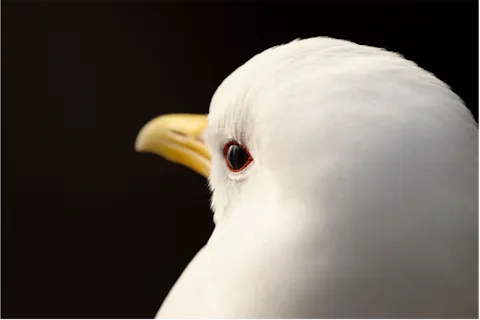The black-legged kittiwake is in danger of extinction in Norway (Endangered (EN) on the national Red List). Over the past 30 years, more than 80% of the population has vanished. Scientists primarily attribute this decline to climate change, although overfishing, pollution, and bird flu also contribute. Despite the urgency of the situation, efforts to ensure the conservation of kittiwakes have been inconsistent, leading to a continued decline in their population.
- Brim Explorer
- Sustainability
- Engaging traveler's in protecting an endangered species in Tromsø

From cliffs to buildings
Kittiwakes find safety in numbers. In the wild, kittiwakes breed on cliffs by the ocean, in dense colonies. They find safety in numbers. However, when colony sizes get smaller, kittiwakes become even more susceptible to predation. They can abandon their cliffs and find shelter in cities. For a kittiwake, a cliff, a facade or a steep roof are pretty much the same thing. But this intrusion of nature in our urban spaces generates conflicts.


The kittiwake hotels
Kittiwakes feed exclusively at sea, and they are peaceful birds who fly silently when a person approaches their nest. But they are otherwise vocal birds, and their dejections leave marks on buildings. Since the first pair bred in Tromsø in 2015, people have tried to ward off kittiwakes. This only made things worse, as the dislodged birds scattered to neighbouring buildings. To compensate for the destruction of the nests and to provide alternative breeding sites, the first kittiwake hotels were put up by the municipality in 2022. At the start of the 2024 breeding season, 8 kittiwake hotels are up, and kittiwakes have adopted them. It is a big success!
Growing empathy for kittiwakes
Reducing the nuisance are essential, but peaceful coexistence will only happen once residents of Tromsø embrace the presence of kittiwakes within the city. And this acceptance hinges on raising awareness and empathy for this true climate refugee. This is precisely the mission of the local nonprofit Wild Lab Projects, which engages the public in the monitoring of the kittiwake population. In partnership with the Norwegian Institute for
Nature Research
Nature Research (NINA), have co-designed citizen science methods that are easily accessible to everyone. They organize walks through the city center to map, count and ring kittiwakes. By experiencing Tromsø from a kittiwake perspective and observing them up close, participants often reconsider their prejudices and become advocates for the kittiwakes.

Citizen science and regenerative tourism
Wild Lab Projects initiated these citizen science walks in 2023, achieving results that surpassed expectations in terms of engagement. These walks welcome participants of all backgrounds, including locals, schools, and travelers seeking an innovative way to discover Tromsø while contributing to the conservation of an endangered species. Travelers also contribute to making tourism more regenerative in Tromsø, as they leave something positive behind, bringing birds and people one step closer to coexistence.
As Brim Explorer, we believe we have a moral responsibility to safeguard, conserve and advocate for the protection of the natural environments that we provide access to for our guests. We also prioritize educating our guests about the fragile existence of these ecosystems. Kittiwakes, besides being seabirds, play a key role in the Norwegian fjords. While we invite our guests to marvel at the natural splendor during our cruises, also empower them to actively engage in local conservation initiatives aimed at protecting these precious ecosystems.